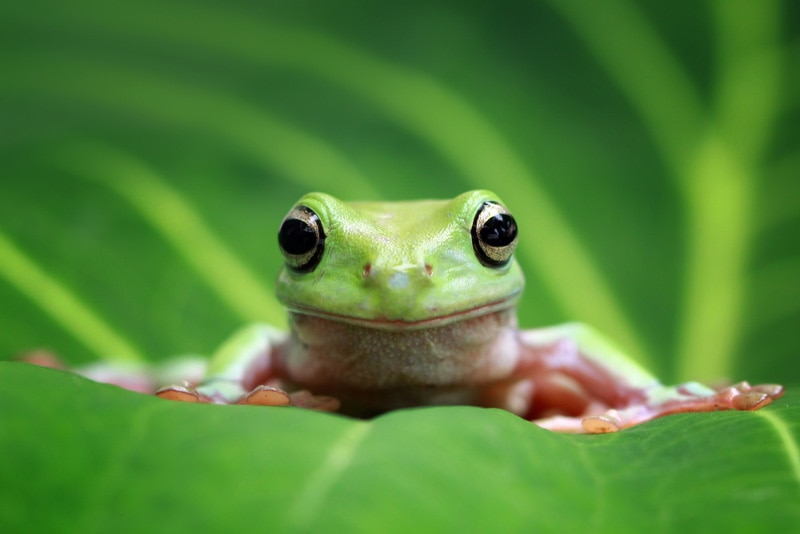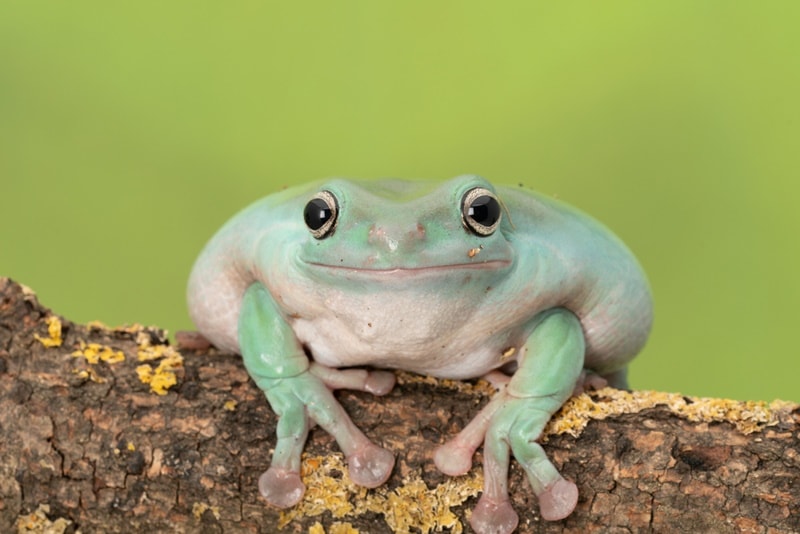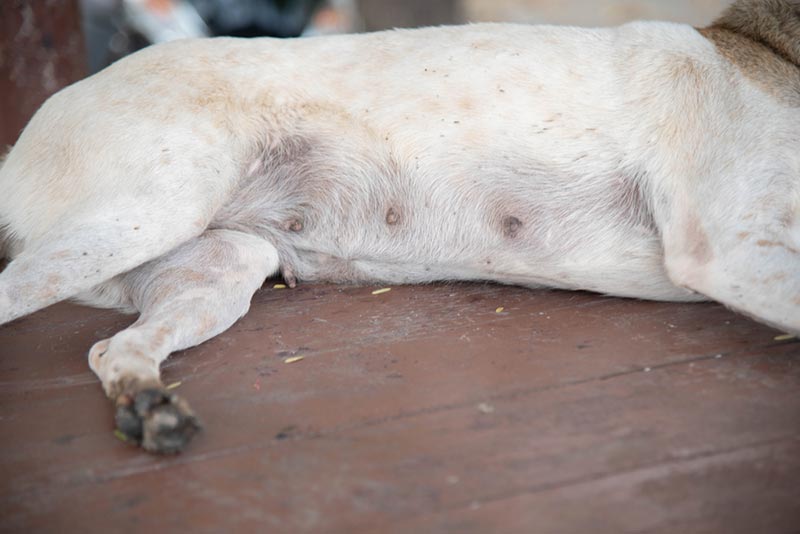What Pet Frogs Can Be Handled: 6 Vet-Approved Species (With Pictures
By Dr. Luqman Javed, DVM (Vet)
Updated on

Frogs make popular and great pets, but if you’re looking for something you can be a little more hands-on with, frogs aren’t for you. Instead, frogs are more meant for looking at, and sometimes listening to. They aren’t for handling. However, there seems to come a time in nearly every pet’s life where a little handling is necessary. With this in mind, there are some frog species that are more suited for occasional handling than others.
Why Shouldn’t Pet Frogs Be Handled?
Generally speaking, most frogs don’t need or care for human contact, and that even extends to some frogs on our list. Their skin is very delicate and semi-permeable, so contaminants can easily pass to them and can make them very ill. On the flip side, frogs can also sometimes carry dangerous pathogens like Salmonella, which can make us sick.
So, basically, pet frogs shouldn’t be handled unless necessary. That means that for the frog species on our list, you can handle them when cleaning their enclosure or to give your responsible child a closer look, but it shouldn’t be an everyday thing. Even “safe” pet frogs should only be handled in short intervals to mitigate the possibility of harming them.

How to Properly Handle Your Pet Frog
Before you go scooping up your pet frog, start by washing and drying your hands and donning some latex or vinyl disposable gloves. Do not reuse gloves; once you’ve handled your frog, you should promptly discard the gloves. This will help prevent the spread of any pathogens between you and your frog, as well as protect your frog from your skin oils and residues. Wear the gloves everytime you handle your frog or anything in their enclosure.
Only handle when necessary and for short periods of time. These aren’t pets that should cuddle on the couch with you during movie time. Only handle them as much as needed to clean their enclosure or check them over for signs of illness.
When you’re finished, remove the gloves and thoroughly wash your hands. With all that said, the frogs here are more open to the idea than the elusive, sometimes poisonous frogs out there in nature. Check out what types you can handle, to an extent, down below, with some relevant info about them each.
The 6 Pet Frogs That Can Be Handled
Frogs on this list are both safe for humans to touch, meaning they don’t possess any poisonous chemicals on their skin, and handle the handling relatively well. Again, just because a frog is on this list doesn’t mean they should be handled regularly. Keep it to an only when necessary event.
1. White’s Tree Frog

| Native to: | Australia, New Guinea, Indonesia |
| Scientific Name: | Ranoidea caerulea/Litoria caerulea |
| Lifespan: | 16 years (average) |
White’s tree frogs can tolerate a wider range of humidity than most pet frogs, and they have uniquely expressive eyes and a quirky “smile” that makes them attractive. Best of all, they’re nearly gregarious by frog standards and can tolerate short periods of regular handling with proper care.
2. White-Lipped Tree Frog

| Native to: | Australia, New Guinea |
| Scientific Name: | Nyctimystes infrafrenatus |
| Lifespan: | 10 years (average) |
Similar but not to be confused with White’s tree frog, the White-lipped tree frog is also considered relatively safe to handle. They are perhaps best known for being the largest species of tree frogs in the world. That being said, in the wild, they’re still considered prey for some animals, such as snakes.
3. African Bullfrog

| Native to: | Africa |
| Scientific Name: | Pyxicephalus adspersus |
| Lifespan: | 45 years (confirmed record) |
Sometimes called pixie frogs, the throaty African bullfrog is a more cantankerous frog to keep as a pet, but has low-maintenance needs. They live for several decades if housed in a large enough habitat, and you can handle them for short periods of time if the frog is agreeable. Some individuals can be aggressive, so it’s very much a case-by-case basis whether the frog can be handled or not. Generally speaking, handling them isn’t advised.
4. Madagascar Tomato Frog

| Native to: | Madagascar |
| Scientific Name: | Dyscophus antongilii |
| Lifespan: | 6 to 8 years (estimate) |
With a colorful name but a shy demeanor and shockingly loud call, the Tomato frog is more likely to want to burrow in a corner than be held, but they may tolerate it for short periods, such as removal for cleaning. This is a calmer frog that won’t try to bite, but they can get stressed out if you handle them for too long, and be sure to wash your hands!
5. Waxy Monkey Frog

| Native to: | South America |
| Scientific Name: | Phyllomedusa sauvagii |
| Lifespan: | 8 to 10 years (estimate) |
Native to the lush Amazon rainforest and surrounding South American tropical climates, the Waxy monkey frog is a nocturnal frog with shiny, waxy skin. This thick skin helps them retain moisture and survive away from their ideal moist habitat. They’re also known to be docile when it comes to handling, but, as always, keep it to just a few minutes occasionally.
6. Crowned Tree Frog

| Native to: | Central America, Costa Rica |
| Scientific Name: | Triprion spinosus |
| Lifespan: | 10 to 15 years (estimate) |
Please Note: Adopting this species isn’t encouraged, as they’re considered threatened in the wild.
With a distinctive crown-shaped cluster of horns, the Crowned tree frog has a famously mellow personality that lends itself to being handled better than others. As long as you avoid touching the pointy crown and very rarely handle using the utmost care, crowned tree frogs can live as long as the average dog.
Do Frogs Like to Be Petted?
No, frogs don’t typically enjoy being petted or touched by humans in the way cats or dogs might like it. Generally speaking, frogs will try to hop away from you rather than be touched unless carefully acclimated to humans. Some frogs are more docile than others, however, and may not immediately try to get away. We don’t recommend petting your frog regularly to avoid stressing them out and to minimize potential health hazards like salmonella.
Conclusion
Let’s get this out of the way: frogs aren’t the pet for you if you want a cuddle buddy. The species on this list, though, are the more amiable ones that are more likely to tolerate a small amount of handling. Every frog, like every dog, has its own threshold for human contact, and it’s important to get to know your frog a bit before handling them. Last but not least, washing your hands and wearing gloves are essential to safely handling your pet frog regardless of species.
Featured Image Credit: Ami_atari-Shutterstock












